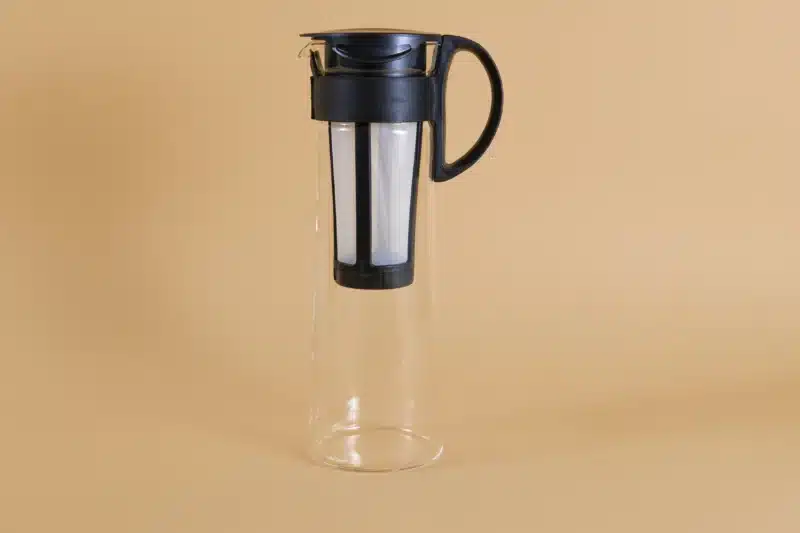
The Hario Mitsudashi Cold Brew Coffee Pot is a simple, reliable way to make smooth cold brew at home. This guide uses the 1-liter pot and includes exact grind guidance for the 1Zpresso K-Max Ultra, storage best practices, and why an optional paper filter can improve clarity and shelf life.
What You Need
- Hario Mitsudashi 1L cold brew pot
- Freshly roasted coffee, medium-coarse grind
- Filtered water
- Kitchen scale (recommended)
Ratio
Start here and adjust to taste:
- 80–100 g coffee
- 1,000 ml water
80 g = lighter, tea-like. 100 g = stronger, more concentrated.
Grind Size for 1Zpresso K-Max Ultra
Target a medium-coarse grind, similar to French press. On the 1Zpresso K-Max Ultra, use the 9-10 setting. This is essentially one full turn and one extra notch if needed. This yields a coarse, even grind that avoids muddiness while extracting well during an 8–12 hour steep.
Tuning: If the brew tastes dull or weak, go slightly finer or increase coffee dose. If it’s bitter or muddy, go coarser or reduce steep time.
Step-by-Step
- Grind. Weigh 80–100 g beans. Grind at ~50–60 clicks on the K-Max Ultra.
- Load. Insert the Mitsudashi mesh basket and add the grounds. Level with a gentle tap.
- Saturate. Pour ~200 ml water over the grounds to wet everything evenly. Wait 1 minute.
- Top up. Add water to reach 1,000 ml. Optional: gently stir inside the basket for a stronger extraction.
- Steep cold. Lid on. Refrigerate 8–12 hours.
Less time = lighter. More time = richer. - Remove basket. Lift out the filter and let it drip a few seconds back into the pot.
- Optional polish. For maximum clarity, pass the brew through a paper filter (details below).
Storage: Keep It Fresh
- Transfer immediately to a hermetic glass bottle (swing-top or airtight carafe). This limits oxygen exposure and flavor drift.
- Store in the fridge at 4 °C. Best within 3 days. Acceptable up to ~5 days if kept airtight and cold.
- Minimize headspace. Fill bottles close to the neck or split into smaller bottles.
Why hermetic? Oxygen drives staling. Airtight storage slows oxidation, preserves aromatics, and maintains sweetness.
Why Add a Paper Filter Pass
The mesh basket leaves fines and oils in suspension. A quick pass through a paper filter after steeping:
- Increases clarity by removing fines for a crisper, cleaner cup.
- Reduces bitterness at the tail by absorbing some oils and ultrafines.
- Improves stability slightly. Fewer suspended particles and oils can slow flavor degradation in the fridge.
If you prefer a heavier body and more “coffee presence,” skip the paper step.
Bean and Roast Guidance
- Single origin for fruit and florals. Blends for chocolate and nuts.
- Medium roast is the safe default. Dark roasts can feel heavy in cold brew; go coarser or shorten steep if using them.
Fast Troubleshooting
- Too weak: finer grind, longer steep, or +10 g dose.
- Too bitter/muddy: coarser grind, shorter steep, or −10 g dose.
- Flat by day 2–3: ensure hermetic storage, reduce headspace, consider paper filtering.
 Sunlight often gets a bad rap due to skin cancer warnings and anti-aging concerns, but when used wisely, daily sun exposure is one of the most natural, powerful health boosters available to us. If you’ve been avoiding the sun out of fear, it’s time to rethink your approach. Here’s how to safely enjoy the sun and reap its many benefits without risking your health.
Sunlight often gets a bad rap due to skin cancer warnings and anti-aging concerns, but when used wisely, daily sun exposure is one of the most natural, powerful health boosters available to us. If you’ve been avoiding the sun out of fear, it’s time to rethink your approach. Here’s how to safely enjoy the sun and reap its many benefits without risking your health. One of my favourite activities at my fitness club is cold water immersion. I willingly submerge my body into a pool of 12-degree water, embracing the cold that offers both a mental and physical reboot.
One of my favourite activities at my fitness club is cold water immersion. I willingly submerge my body into a pool of 12-degree water, embracing the cold that offers both a mental and physical reboot.

